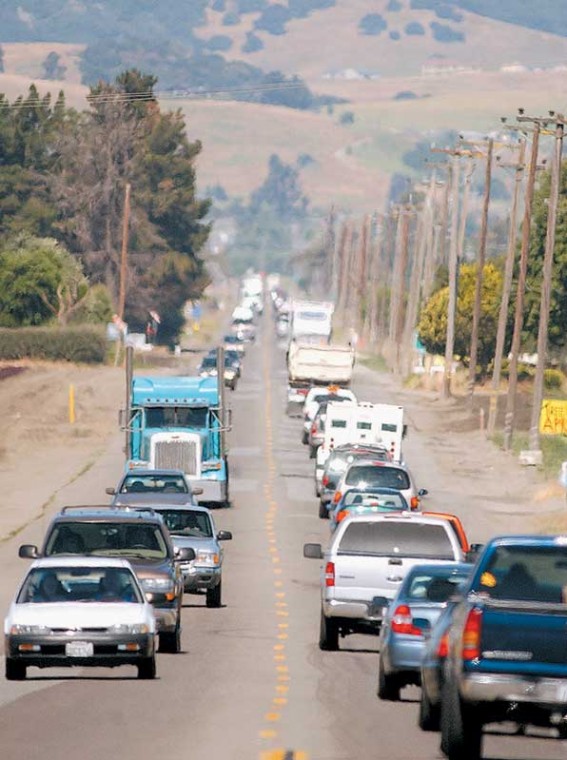
Hollister
– The prospects of two local highway projects received a serious
blow on Friday, when the staff of the California Transportation
Commission released its first recommendations for Proposition 1B
funding.
Hollister – The prospects of two local highway projects received a serious blow on Friday, when the staff of the California Transportation Commission released its first recommendations for Proposition 1B funding.
Neither the widening of Highway 101 from Monterey Street to Highway 25 – which would include a new 101-25 interchange – nor the widening of Highway 156 are recommended for state funding. The interchange of San Juan Road and Highway 101, a less high-profile project, was also denied funding.
The commission won’t actually vote on the spending list until Tuesday, but county officials said it’s unlikely anything will change.
“This commission is not going to overturn its staff,” said Mike Graves, who served as legislative analyst for the San Benito County Council of Governments until the end of last year.
COG Executive Director Lisa Rheinheimer said she was particularly surprised and disappointed that funding for Highway 101 and the Highway 25 interchange was not approved, because it’s an important project with an inter-regional impact.
“(The decision) is not good for San Benito County,” Rheinheimer said.
Friday’s announcement doesn’t mean the projects won’t happen, she added, but they are going to be delayed until funding can be found.
Local commuters also said they were disappointed, particularly since the widening of Highway 101 from four to six lanes would have included the construction of a full “clover” interchange between Highways 25 and 101. The project is budgeted to cost $128 million; California’s Department of Transportation estimated that the project could have saved commuters a collective 142,882 minutes during peak driving hours every day.
Hollister resident Kent Child said that during rush hour, the current interchange is a traffic nightmare.
“It’s just so bottled up there that it’s hard to even get into the overpass,” he said.
Child used to commute regularly to Gavilan College, where he worked as a dean and an instructor. Now that he’s retired from teaching, Child still makes the drive, albeit less frequently, because he sits on the college’s board of trustees.
Child also noted that the current interchange was only intended to be a temporary fixture until the full interchange could be built.
Hollister resident John Rinck, who commutes to San Jose, agreed that traffic backs up from the interchange onto Highway 101 during his drive home. On Fridays, he said, traffic stays clogged until 7pm.
Rinck favors outlawing left turns from 25 onto southbound 101, but he said that’s only a short-term solution.
“In the long-term, this project is really necessary,” Rinck said.
Commuters on Highway 156 have also complained that traffic gets backed up during peak hours. Widening the highway from two to four lanes would cost $66 million and, according to Caltrans, save commuters 46,178 minutes per day.
However, the project has also drawn criticism, particularly from San Juan Bautista residents. The project’s detractors said they are worried about the loss of agricultural land and increasing noise from truck traffic.
San Juan Bautista Councilman George Dias, who chairs the COG board, falls squarely in the opposing camp. Dias said he’s glad Highway 156 didn’t get any funding, because truck traffic on the highway is “wrecking our town.”
The recommendations released Friday account for $2.8 billion of the $4.5 billion to be distributed through the Corridor Mobility Improvement Account. The account is itself only a fraction of the $20 billion that will be raised by the sale of bonds approved through Proposition 1B.
Rheinheimer said she’s hopeful about the second round of funding, which is scheduled for 2008.
Some county residents have said a rural area like San Benito is likely to be overlooked in favor of the state’s urban regions. Indeed, Los Angeles and Orange counties alone account for nearly 25 percent of the CMIA funding.
But Graves said San Benito can still get its share of the pot if it bands together with neighboring counties. He said that’s how counties in San Joaquin Valley were able to receive more than $135 million.
“We’re going to need some real leadership,” Graves said.
Hollister Mayor Brad Pike, who also serves on COG’s board of directors, said he and other local leaders are going to do whatever it takes to get money in the second round. Pike previously succeeded in lobbying the state to fund safety improvements to Highway 25.
“If they need us to go to Sacramento again, I’m willing to do that,” he said.
Anthony Ha covers local government for the Free Lance. Reach him at 831-637-5566 ext. 330 or ah*@***********ws.com.









